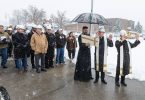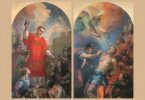by Joe Bollig
joe.bollig@theleaven.org
KANSAS CITY, Kan. — For many people, that special time of preparation before Christmas has a very special name.
Shopping season.
If ever it needed one, the patron saint for Christmas “shopping season” is the worldly wise Lucy van Pelt in “A Charlie Brown Christmas.”
“Look, Charlie Brown,” said Lucy. “We all know that Christmas is a big commercial racket. It’s run by a big Eastern syndicate, you know.”
It’s easy to be cynical about the commodified Christmas, especially when trees and ornaments have been appearing in stores since late September.
Thank God there is an antidote for the crass, materialistic, frenetic, greedy and depressing “shopping season.”
It’s called Advent.
The word “Advent” comes from the Latin “adventus,” which means “coming,” “arrival” or “approach.” It refers, of course, to one of the greatest truths of Christianity: the incarnation of Jesus the Christ.
Advent is a joy-filled time of preparation for the birth of Jesus, the Christmas gift of all gifts. During this four-week period, Christians prepare their hearts, minds and souls to welcome their savior. It is a time of introspection, celebration and prayer.
The church begins a new liturgical year on the First Sunday of Advent. This year, the four Sundays of Advent are Nov. 29, Dec. 6, Dec. 13 and Dec. 20.
Many wonderful Advent traditions have developed over the centuries — some of them very hands-on and child-friendly. So, round up the kids and use this season to pass on to them your Catholic faith through activities and devotions that they can then someday enjoy with their children.
What’s the key to a successful family Advent? Keep it simple, keep it fun, make it prayerful, and, above all, be creative!
Merry Advent to you!
Gather round the wreath
The tradition of the Advent wreath began with German Lutherans and spread to Catholics and other Christians around the world.
Traditionally, the wreath is made of evergreen branches bound into a circle and laid flat on a surface or in a holder. Even Styrofoam rings can serve as the base of a simple wreath.
Making an Advent wreath as a family project is easy, but keep fire safety in mind when choosing your materials.
Families with small children might want to use votive candles in glass holders. If using taper or pillar candles, make sure they are tall enough to keep the flames away from the wreath material. Consider using fire-resistant materials for the wreath. To bind the wreath you can use wire or floral sticks. Any craft or discount store will have the materials.
The traditional wreath calls for four candles evenly placed around the ring, like four points on a compass. Three of the candles are usually purple, to symbolize penance, prayer and the royal lineage of Jesus. The fourth is pink or rose. (This candle is for the Third Sunday of Advent, this year Dec. 13. It is “Gaudete Sunday,” from the Latin word which means “rejoice.”)
Some families also put a large, white candle in the center — the Christ candle — to be lit on Christmas Eve or Christmas.
The devotion starts on the First Sunday of Advent, when the family gathers for prayer and lights the first purple candle. (Find sample prayers below.) It doesn’t matter which purple candle is lit first, but generally the order in which the candles are first lit is the order in which they’re lit throughout the season.
For the first week of Advent, only the one candle is lit for the prayer service. On the Second Sunday of Advent, both the first and a second purple candle will be lit for the prayer service and throughout the week. (Many families light their wreath before or after the evening meal.) The pink candle is lit for the first time on the Third Sunday of Advent, so that week three candles are lit for the service.
The final and fourth candle is lit on the Fourth Sunday of Advent, so from that day through Christmas, the entire wreath is lit. Those that utilize the white candle light it on Christmas Day.
Although many lengthier or more interactive Advent prayer services are available in books and online if all family members are old enough to read, the following simple service is a great place to start. It is excerpted from “A Prayer Book of Catholic Devotions” by Loyola Press. A slightly longer service is available at: www.scborromeo.org/prayers/adventwreath.pdf.
First Week
Leader: All-powerful God, increase our strength of will for doing good that Christ may find an eager welcome at his coming and call us to his side in the kingdom of heaven, where he lives and reigns with you and the Holy Spirit, one God, forever and ever. Response: Amen.
Second Week
Leader: God of power and mercy, open our hearts in welcome. Remove the things that hinder us from receiving Christ with joy so that we may share his wisdom and become one with him when he comes in glory, for he lives and reigns with you and the Holy Spirit, one God, forever and ever. Response: Amen.
Third Week
Leader: Lord God, may we, your people, who look forward to the birthday of Christ experience the joy of salvation and celebrate that feast with love and thanksgiving. We ask this through Christ our Lord. Response: Amen.
Fourth Week
Leader: Father, all-powerful God, your eternal Word took flesh on our earth when the Virgin Mary placed her life at the service of your plan. Lift our minds in watchful hope to hear the voice which announces his glory and open our minds to receive the Spirit who prepares us for his coming. We ask this through Christ our Lord. Response: Amen.
Decorate your family tree
The Advent tradition of the Jesse Tree comes from art created in medieval times to portray the ancestors of Christ — the family tree of Jesus. Sometimes, this genealogy was depicted in stained-glass windows, in murals, carvings and book illustrations.
The name of the Jesse Tree is taken from Jesse of Bethlehem, the father of King David. The reference to Jesse is in the messianic prophesy of Is 11:1-17. It begins, “But a shoot shall sprout from the stump of Jesse, and from his roots a bud shall blossom.”
Other scriptural references to the genealogy of Jesus can be found in Lk 3:23-38 and Mt 1:1-17.
The ornaments of the Jesse Tree are symbols of persons and events leading up to the birth of Jesus. It’s a great way to teach young children why Catholics believe Jesus was the same Messiah eagerly awaited for centuries by the Israelites.
Your family’s Jesse Tree can be a paper or felt poster on a wall or the refrigerator, a stand-up poster on a table, or a bare branch in a flower pot full of stones, marbles, sand or dirt. It can resemble a small, bare sapling, or a traditional fir Christmas tree — it doesn’t matter. You can buy the ornaments, but it’s more fun to make them!
Like the lighting of the Advent wreath, the hanging of the Jesse Tree ornaments is done with prayer. How often you hang ornaments on the Jesse Tree depends on how many children you have (everyone will want to hang one!) and the number of ornaments used per day.
Your ceremony can include traditional prayers such as the Our Father, Hail Mary and Glory Be; a simple prayer/prayers you and your children write yourselves; and a reading of a short Scripture passage associated with an ornament.
Of course, you can also add your own ornaments symbolizing your family members, since you, too, are part of the family of God. Feel free to add any other symbols of salvation history that can be found in the Bible.
Here’s a list:
- The world created: globe (Gn 1:24-28)
- Adam and Eve: woman or man, and/or snake and apples (Gn 3:1-24)
- Noah and the flood: ark, rainbow or dove (Gn 6:11-22; 8:6-12)
- Abraham: camel, tent or stars (Gn 12:1-7; 13:2-18; 15:5; 18:1)
- Sarah: baby (Gn 18:1-5; 21:1-7)
- Isaac: ram, altar of sacrifice (Gn 22:1-18)
- Jacob: ladder and/or angel (Gn 28:10-12; Gn 32:25-30)
- Joseph: coat of many colors, bag of 20 pieces of silver (Gn 37:1-36)
- Moses: burning bush, Passover lamb, tablets of the Law, Ark of the Covenant (Ex 3:1-10; Ex 12:1-10; Ex 20:1-17; Ex 25:10-22)
- Miriam: tambourine, (Ex 15:19-21)
- Samuel: lamp (1 Sm 3:1-21)
- Jesse: branch (Is 11:1)
- David: six-pointed Star of David, harp, (1 Sm 16:14-23)
- Solomon: crown (1 Kgs 3:3-28)
- Isaiah: throne (Is 6:1-8)
- Jeremiah: potter’s flask (Jer 19:1-13)
- Angels: angel (Heb 1:1-14)
- Malachi: trumpet (Mal 3:1-4)
- Zechariah and Elizabeth: baby (Lk 1:39-45)
- Blessed Virgin Mary: angel (Lk 1:26-35)
- John the Baptist: river (Mt 3:1-6)
- Joseph of Nazareth: woodworking tools (Mt 1:18-25)
- Bethlehem: Christmas star (Mt 2:1-12)
- Nativity, birth of Jesus the Christ: donkey and/or manger (Lk 2:1-14)
Celebrate the family
Designate one night each week of Advent as family night. Ask older kids to mark their calendars and remind little ones of it throughout the week. Then, on the designated night, turn off the television, computers and other digital devices in the evening and undertake one of the following projects:
- Lots of people love to make gingerbread houses this time of year. With some candies, graham crackers and frosting, your family can construct a “gingerbread” Christmas crèche or church.
- Make your own heirloom Christmas crèche. There are no hard-and-fast rules in terms of construction. Use paper, cardboard, Popsicle sticks and glue, twigs and branches collected in the yard, items from a craft store — anything. The figures can be drawn on cardboard cutouts, or out of homemade modeling clay. (The recipes are easy to find online. One is: 1 cup water, 4 cups flour, 1 cups of salt. Mix and keep moist. It dries to a rocklike hardness. Paint or color as desired).
- Wise men journey. This is a kind of a game, and you can make it as simple or complicated as you wish. Every day (or every Sunday) of Advent, have the oldest child (or parent) hide the three Christmas crèche wise men (or three kings) in the house, then send the younger child out to find them. When they do, the wise men are placed in a predetermined place. As Advent progresses, move the wise men closer and closer to the Christmas crèche until finally, on Jan. 6, or Epiphany — also known as the Feast of the Three Kings — they arrive at the stable.
- Celebrate St. Nicholas Day. There are several traditions relating to St. Nicholas Day, which is celebrated on Dec. 6. One tradition is for the children to leave out their shoes filled with hay, an apple or carrot for St. Nicholas’ horse. In the morning, the “horse food” is gone — replaced with candy or a small toy.
- Bake a St. Lucy cake or buns. You can celebrate this tradition in as complicated or as simple a manner as you want. The feast of St. Lucy is celebrated on Dec. 13 all over Europe. In Sweden, it is traditional for the eldest daughter to wake up the family while singing a hymn to St. Lucy and wearing a white robe, red sash and a crown of whortleberry twigs having nine lighted candles. She serves saffron cakes or “S” shaped buns called Lussekatt. For your family, any store-bought saffron cake mix or sweet bread will do, and you can make them as a special breakfast food or just for dinner. If you want to, you can research authentic St. Lucy saffron cake and buns recipes online. For the sake of fire safety, if you want crowns for little heads, make them out of paper. If you want lights, choose small, battery-powered LEDs.
- Pray a family prayer around the Christmas tree. This is the simplest suggestion of all, and is appropriate for any size family, with children of any age. Either before or after putting up and dressing the tree, say a prayer of thanksgiving for blessings received in the past year and of invitation to the Christ Child to enter into the hearts of the family members gathered.
Find a way to reach out
Not all Advent traditions are devotional in nature.
Here are some other things families can do to celebrate the season.
- Buy a fancy Christmas stocking or box and pack it with goodies for an individual (or more) at a homeless shelter or a resident at a retirement facility. Be sure to call ahead to ask what things are needed or prohibited, or if there are special requests or considerations.
- Collect and donate food and personal care items to a food pantry. Again, contact the pantry to see if there is a need for particular items. They may have all the candy canes they need, but desperately need formula and diapers.
- Go Advent caroling. Make little songbooks of Advent hymns and then hit the sidewalks. You might also visit nursing homes, the elderly and shut-ins. Ask your pastor about making “special stops” at the homes of those who might appreciate a visit. Take along little gifts — like candy canes, a holy card, etc. — to leave behind.
- Collect “Christ Child coins” in a specially decorated bank and donate what you save to a ministry of the church.
- Fill the manger for the Christ Child. Make a shoebox-sized “manger.” Cut strips of yellow or brown construction paper into strips of “straw” -inch wide and about 10- to 12-inches long. At dinner each night, children and parents should share their good works and sacrifices during the day, after which Mom and Dad will award each child (and themselves) what they think is an appropriate amount of “straw” to place in the manger. A doll can be placed in the manger on Christmas Eve to represent the Christ Child.







